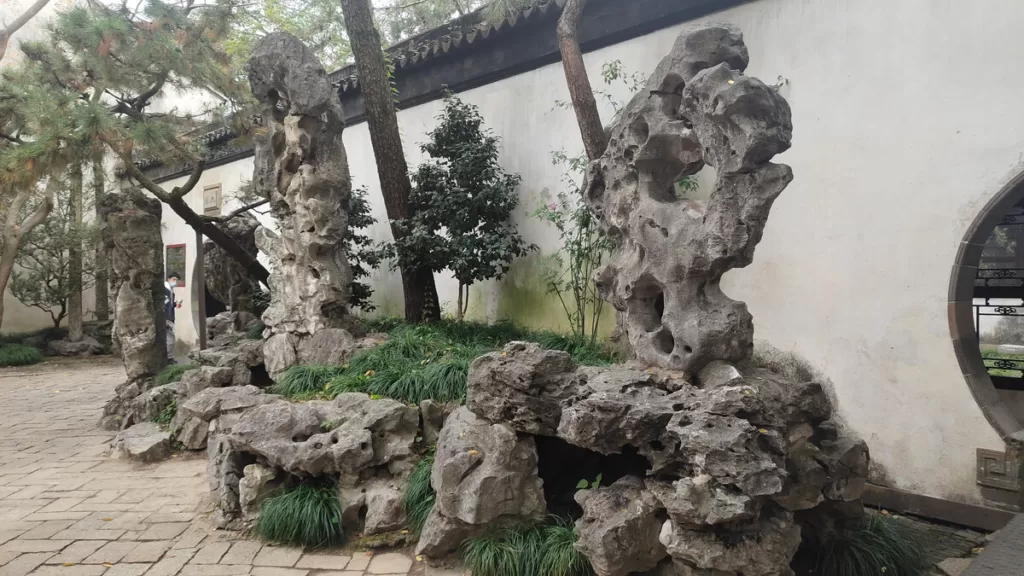Felsen im Garten des bescheidenen Verwalters - eine Darstellung der Gelassenheit


Nestled in the heart of Suzhou, China, the Humble Administrator’s Garden (拙政园) stands as an enduring testament to the timeless beauty and wisdom of classical Chinese garden design. Regarded as one of the most exquisite gardens in the world, this masterpiece was created during the Ming dynasty in the early 16th century. Among its many treasures lie the carefully selected and artfully arranged rocks, each with its own unique character and significance. In this essay, we shall delve into the ethereal beauty and philosophical depth of the rocks that grace the Humble Administrator’s Garden.
The origins of these rocks trace back to the distant mountains, where skilled artisans sought out and meticulously selected each stone, appreciating its shape, texture, and aura. These rocks, collectively referred to as “scholar stones” or “spirit stones,” are more than mere decorative elements; they embody the essence of nature itself. Some rocks are jagged, reminiscent of rugged mountain peaks, while others are smooth and serene, resembling tranquil riverside boulders. Through these rocks, the garden connects the viewer to the vastness of the natural world and evokes a sense of nostalgia for the distant landscapes of the homeland.
One of the most prominent rocks in the Humble Administrator’s Garden is the “Yunyan Stone,” also known as the “Cloud Rock.” Its picturesque appearance resembles a craggy mountain engulfed in mist and cloud, conjuring a sense of mystery and grandeur. It stands as a focal point of the garden, symbolizing strength, endurance, and the ever-changing nature of existence. Visitors often find themselves pondering the ephemeral and transient nature of life when gazing upon this majestic stone.
Another remarkable rock, known as the “Listening to the Sound of Water Rock,” captures the imagination with its graceful curvature and hollow structure. Placed near a tranquil water feature, it amplifies the melodic sounds of water gently flowing through the garden, encouraging visitors to embrace the harmonious relationship between humanity and nature. The Chinese believe that listening to the soothing sound of water is an art in itself, capable of calming the soul and nurturing one’s inner self.
Adjacent to the “Listening to the Sound of Water Rock” stands the “Flying Rainbow Bridge Stone,” a mesmerizing creation that appears as if a colorful bridge is suspended in mid-air. This rock epitomizes the delicate balance between illusion and reality, representing the transient and ever-changing nature of existence. The Chinese philosophy of impermanence, symbolized by this stone, reminds visitors to cherish the present moment and find contentment in the transient beauty of life.
The “Cracked Ice Stone” is a unique rock that captivates with its intricate web of cracks, reminiscent of ice forming on a frozen lake. This stone symbolizes resilience and the ability to endure even in the harshest of conditions. The garden’s designers ingeniously placed it next to a water feature, where it appears to float on the water’s surface. This subtle arrangement reminds visitors of the interplay between strength and flexibility, echoing the teachings of Confucianism and Taoism.
In contrast to the powerful and majestic rocks, there are also smaller stones artfully positioned to evoke contemplation and serenity. The “Wisdom Nurturing Stone,” characterized by its gentle slopes and subtle crevices, encourages introspection and self-discovery. It exemplifies the idea that wisdom and knowledge must be nurtured like a delicate plant, requiring patience and attentiveness to flourish.
The allure of the rocks in the Humble Administrator’s Garden extends beyond their physical form. It is a spiritual journey, an exploration of nature’s boundless beauty and a reflection of the human spirit’s resilience. These stones transcend the realm of art and become vessels of philosophical teachings, inviting visitors to meditate on the cycles of life, the harmony of existence, and the impermanence of all things.
In conclusion, the rocks of the Humble Administrator’s Garden symbolize much more than mere embellishments in a splendid garden; they embody profound philosophical concepts, offer spiritual guidance, and connect visitors to the essence of nature. As the sun sets over this enchanted realm, the rocks stand as eternal witnesses to the wisdom of the past, enriching the present and inspiring generations yet to come.
Fakten über den Garten des bescheidenen Verwalters